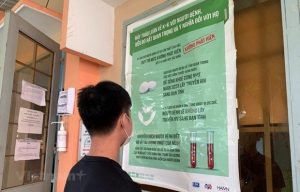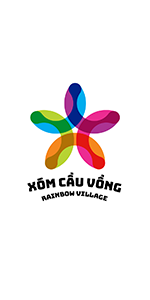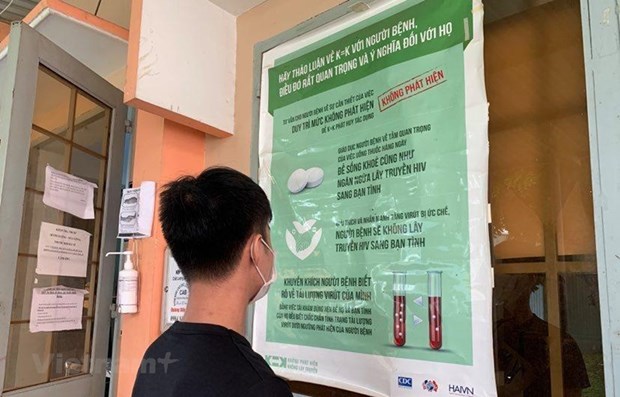Up to 48% of people newly diagnosed with HIV/AIDS are in the 16-29 age range, and alarmingly high rate of infections among youngsters, according to Associate Professor Phan Thi Thu Huong, Director of the Anti-HIV/AIDS Department
Hanoi (VNA) – Up to 48% of people newly diagnosed with HIV/AIDS are in the 16-29 age range, and alarmingly high rate of infections among youngsters, according to Associate Professor Phan Thi Thu Huong, Director of the Anti-HIV/AIDS Department

Huong cited data from the Joint United Nations Programme on HIV/AIDS (UNAIDS) showing that by the end of 2021, the world recorded about 38.4 million people living with HIV. In 2021, there were 1.5 million new HIV infections worldwide and 650,000 AIDS-related deaths. The HIV epidemic is most distributed in Africa (about 25.6 million people currently living with HIV). The global trend of new HIV infections continues to decline.
In the Asia-Pacific region, as of 2021 there were 5.7 million people living with HIV. In the year, there were 260,000 new infections, of which about 14,000 were children under 15 years old, and 128,000 people died from AIDS. New HIV-infected subjects were mainly men who have sex with men (MSM) (accounting for 53%).
In Vietnam, since the first case was detected in 1990 in Ho Chi Minh City, as of October 2022, the whole country had had 220,580 living HIV-infected people and 112,368 people with HIV had died, according to reports from provinces and centrally-run cities. The epidemic is concentrated mainly in the Southeast region and the Mekong Delta region, accounting for nearly 80% of newly detected infections nationwide, in which Ho Chi Minh City had a quarter of newly detected infections nationwide, and mainly in men (over 80%), she said.
Huong noted that from 1990 to 2015, the proportion of men infected with HIV tended to decrease slightly, but from 2016 the proportion of men infected with HIV began to increase again. In the early stages of the epidemic, HIV infection was mainly transmitted through blood, but in recent years, infection through unprotected sex has become the main route of transmission in newly discovered HIV infections
In the first 10 months of 2022, 9,025 new cases of HIV infection had been diagnosed, along with 1,378 HIV-related deaths. The number of people newly diagnosed cases was the age group of 16-29 (48%) and 30-39 (28%). The main method of transmission was unsafe sexual activities (81%).
In Vietnam, the MSM group has become the group with highest risk level, stated Huong.
According to the expert, currently, HIV screening has covered 100% of districts with more than 1,300 facilities and HIV confirmation testing scattering in 100% of provinces and cities with 204 confirmed laboratories. HIV confirmatory testing is extended to the district level with 97 confirmatory laboratories. The HIV confirmation laboratory system using rapid tests has been piloted in mountainous and remote areas. New infection testing methods have been deployed in 28 provinces and cities across the country, Huong said.
PrEP (Pre-exposure prophylaxis) activities have been fruitful in many forms, she added.
Huong said that currently, there are 499 HIV treatment facilities nationwide, of which 362 are providing ARV drugs covered health insurance to 167,022 patients, of which 3,453 are children and 163,568 adults.
The health sector is also expanding ARV treatment through health insurance. Vietnam has been among few countries that have achieved the target of 95% of all people receiving antiretroviral therapy to have viral suppression, Huong stressed.
Regarding difficulties and challenges facing HIV/AIDS prevention and control activities in Vietnam, Huong pointed to problems in ensuring public health, challenges in financial resources and the increasing use of drug and meths among MSM group. Meanwhile, there is no specific HIV/AIDS treatment drug in the world as well as in Vietnam, she said.
The expert lauded the theme of the Vietnam HIV/AIDS Day 2022 of “Putting an end to AIDS – Are youngster ready?”. According to the 2021 census data, the rate of comprehensive understanding of HIV prevention among boys and girls aged 15-24 years was just under 50%. The rate of discriminatory attitudes towards HIV among 15-24-year-old boys and girls was nearly 40%. Thus, this age group has very limited knowledge and attitude compared to the common target of Vietnamese people aged 15-49 of 80% in both indicators, she noted.
Therefore, the group must receive greater attention in the future when Vietnam realises the goal of putting an end to AIDS by 2030, Huong stated./.
VNA

